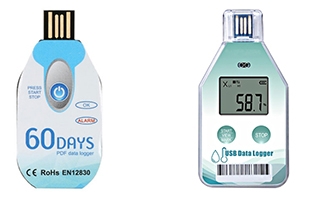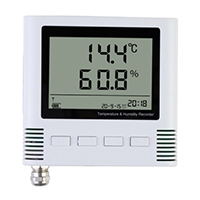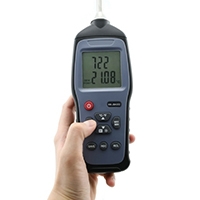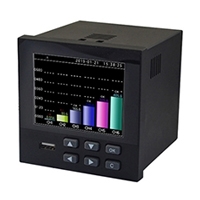A temperature data logger is a device used to measure and record ambient temperature. It is usually used to monitor and record temperature changes, especially in situations where a specific temperature range needs to be maintained, such as cold chain transportation, food storage and transportation, pharmaceuticals, laboratories, medical equipment, and other fields.
These loggers are capable of measuring ambient temperature periodically or continuously over some time and storing the data in internal memory. Some advanced temperature data loggers have other sensors, such as a humidity sensor, to record humidity changes in the environment. These temperature data loggers are usually portable and can be easily placed within the area to be monitored, while some are also designed for fixed installation.
Using a temperature data logger can help ensure that temperatures are maintained within the proper range in environments that require strict temperature control to prevent product damage, reduced quality, or safety issues. Additionally, the data provided by the loggers can be used for traceback and analysis to understand patterns and trends in temperature fluctuations.
Working Principle
Temperature data loggers sense ambient temperature changes through temperature sensors, convert these data into digital signals, and record them in internal memory with time stamps and possible communication interfaces so that users can access, analyze, and manage temperature data at any time. The following is the composition of a temperature and humidity data logger.
- Temperature Sensor: Temperature data loggers are typically equipped with one or more temperature sensors, such as thermocouples, thermistors (RTDs), or semiconductor temperature sensors. These sensors sense temperature changes in the surrounding environment.
- Signal conversion: The physical signals produced by temperature sensors (such as voltage or resistance changes) need to be converted into digital signals for storage and processing. This step is usually accomplished by an analog-to-digital converter (ADC).
- Data storage: The converted digital signal is recorded in a data storage device, such as internal memory, SD card, or other types of storage media. This allows the device to continuously record temperature data even when the device is not connected to a computer or other external device.
- Timestamps: To track changes in temperature over time, temperature data loggers often add timestamps. This allows users to analyze temperature data for trends and associated events.
- Power management: Temperature data loggers are typically battery-powered, so the device also includes an efficient power management system to extend battery life. This may include sleep modes, low-power electronics, and periodic wake-ups.
- Communication interface: Some temperature data loggers have communication interfaces, such as USB, Wi-Fi, or Bluetooth, to transfer stored data to a computer or other device for further analysis and monitoring.
Types of Temperature Data Logger
Disposable Temperature Data Logger

A disposable temperature data logger is a device used to monitor and record temperature changes. These devices are typically designed for single use to obtain critical temperature information when transporting, storing, or transporting temperature-sensitive items. Disposable temperature data loggers typically have compact sizes and simple user interfaces to facilitate quick deployment and configuration.
These data loggers have built-in sensors that measure the temperature in the environment and store the recorded data in internal memory. After the device completes its task, the user can retrieve the recorded temperature data by connecting to a computer or other device. Since they are single-use, users do not need to worry about recycling or reusing the device, which makes them more convenient in certain application scenarios.
Digital Temperature Data Logger

A digital temperature data logger is a device used to monitor and record ambient temperature. It typically includes sensors to measure temperature and stores this data in digital form in internal memory.
These loggers usually have a compact design and are easy to carry, making them suitable for different work scenarios. Its main functions include real-time monitoring of temperature, recording temperature changes, setting alarm thresholds, and providing timestamps. Digital temperature data loggers play an important role in ensuring the quality and safety of temperature-sensitive items, while also providing reliable temperature data for research and experiments.
Wireless Temperature Data Logger

A wireless temperature data logger is a device that can monitor and record temperature changes in real time. It usually consists of sensors, data storage units, and wireless communication modules. The sensor is responsible for sensing temperature changes in the environment and transmitting the data to the data storage unit. The data storage unit records temperature data and transmits this data to a remote device or cloud server through a wireless communication module. In this way, users can view temperature trends in real-time through mobile phones, computers, or other devices, and can also remotely monitor temperature conditions to ensure that the environment is within the appropriate temperature range. This kind of wireless temperature data logger is widely used in medical, food storage, transportation, and other fields to help ensure the temperature stability and safety of items or environments.
Multi-Channel Thermocouple Data Logger

A multi-channel thermocouple data logger is a device used to measure and record input from multiple thermocouple sensors. A thermocouple is a temperature sensor that generates a voltage signal by measuring the temperature difference between different metals to determine the temperature value. For example, sisco thermocouple data logger has 12 channels, each of which can be connected to a thermocouple sensor. By recording data from multiple channels simultaneously, users can monitor and record temperature changes in multiple locations or environments on the same device.
Such devices often include storage capabilities that allow users to analyze or examine the data at a later stage. These recorded data can be used to monitor temperature changes, analyze thermal processes, or perform quality control in experimental and industrial applications.
USB Temperature Data Logger
A USB temperature data logger is a portable device used to monitor and record changes in ambient temperature. It is usually connected to a computer or other device through a USB interface so that users can easily download and analyze temperature data. This type of data logger is commonly used in a variety of applications including laboratory research, healthcare, food transportation and storage, and more. They feature highly accurate sensors that measure a wide range of temperatures and can record temperature data at predetermined intervals.
Users can view, export, and analyze temperature data by connecting the data logger to a computer and using the corresponding software. Some USB temperature data loggers also have alarm functions, and users will receive alarm notifications when the temperature exceeds a set threshold.
Temperature and Humidity Temperature Data Logger
A temperature and humidity data logger is a device used to monitor and record ambient temperature and humidity. It includes sensors, data storage devices, and interfaces for configuring and retrieving data. The basic function of a temperature and humidity data logger is to regularly measure and record temperature and humidity data. They can be set to take measurements at predetermined intervals and store data in internal memory or on an external memory card. Some advanced data loggers may also have wireless communication capabilities, allowing users to access data remotely via the Internet or other means.
These devices are often used for environmental monitoring and compliance recording, such as maintaining stable temperature and humidity during pharmaceutical storage or tracking environmental changes during laboratory experiments. Using a temperature and humidity data logger helps ensure that accurate environmental data is available when needed and is an important tool in many applications.
Applications
- Industrial Sector: Temperature data loggers play a key role in the industry to monitor and record temperature changes during production processes. Industrial equipment often needs to operate within a specific temperature range, and temperatures that are too high or too low may cause equipment failure or product quality issues. Through the temperature data recorder, engineers can monitor the temperature situation in real-time and take timely measures to ensure the stability and efficiency of production. In addition, temperature data also provides an important reference for the maintenance and performance optimization of industrial equipment.
- Medical field: In the medical field, temperature data loggers are widely used to monitor the temperature conditions of pharmaceuticals, vaccines, and biological samples. It is crucial to keep these items within specific temperature ranges to ensure their effectiveness and safety. Temperature data loggers provide reliable temperature histories to help verify the quality and compliance of medical items. This is critical to complying with healthcare industry regulations and standards and is a critical step in ensuring patient safety.
- Food industry: In food processing and storage, temperature control is critical to food quality and safety. Temperature data loggers are used to monitor temperature changes during refrigeration, freezing, and cooking processes to ensure food safety throughout the supply chain. This helps prevent the growth of bacteria in food, extends the shelf life of food, reduces food waste, and is a necessary measure to comply with food safety regulations.
- Laboratory research: In scientific laboratories, especially in the life sciences, temperature data loggers are a critical tool in the design and execution of experiments. They are used to monitor the temperature of laboratory environments and equipment to ensure the stability of experimental conditions. This is crucial for the accuracy and reproducibility of experimental results in biological experiments, drug development, and other fields.
- Environmental monitoring: Temperature data loggers have a wide range of applications in environmental science and meteorology. They are used to monitor climatic conditions, surface temperatures, and atmospheric temperatures to study climate change, understand the effects on natural ecosystems, and provide meteorological data for weather forecasting. This provides valuable information for environmental protection and natural resource management.

